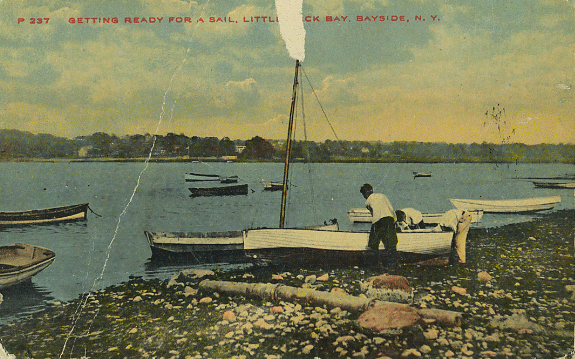Vintage Postcards of Bayside, New York
Getting Ready for a Sail
Little Neck Bay has always been an integral part of our community. From the earliest times, the bay not only served as a plentiful source of food for the Matinecocks, the shells found along the shore were used to make currency called wampum. Bead wampum was ground and polished and then bored through with a small hand drill. White wampum could be made from a variety of shells, but the more desirable and rare violet wampum came from the purple portion of the quahog clam.
Later, during the 19th Century, clamming in Little Neck Bay provided a livelihood for many and the recreational aspect of the Bay was discovered as well. While the shoreline is fairly rocky there were points along the Bay that served as small beaches and bathers also enjoyed swimming from floats moored off shore. Many of the more elaborate estates in Bayside lined the bay boasting coveted views and riparian rights.
By the turn of the 20th Century, the bay was highly touted in real estate advertisements and auctions for both its scenic quality and recreational value. Several boating clubs cropped up in Bayside including the Bayside Yacht Club, the Little Neck Bay Yacht Club, and the Clearview Golf and Yacht Club.
In the 1930s Robert Moses and the City of New York began construction of the Cross Island Parkway and all property owners lost direct access to the beach including riparian rights. The City built a bridge over the parkway at 28th Avenue to a pier and launching facility that replaced the one built by the Bayside Yacht Club and opened it to the public.
Today, the Bayside Marina is held under the auspices of the New York City Parks Department and is run by a private concessionaire. With 25 slips and 50 moorings, the marina is open from May through October.

